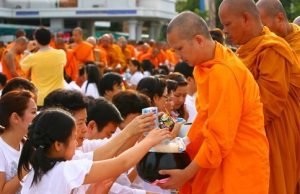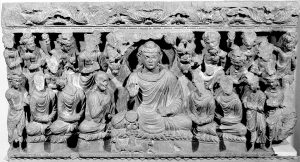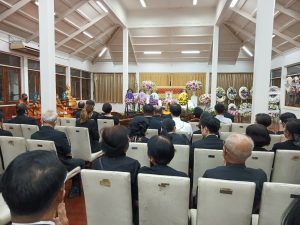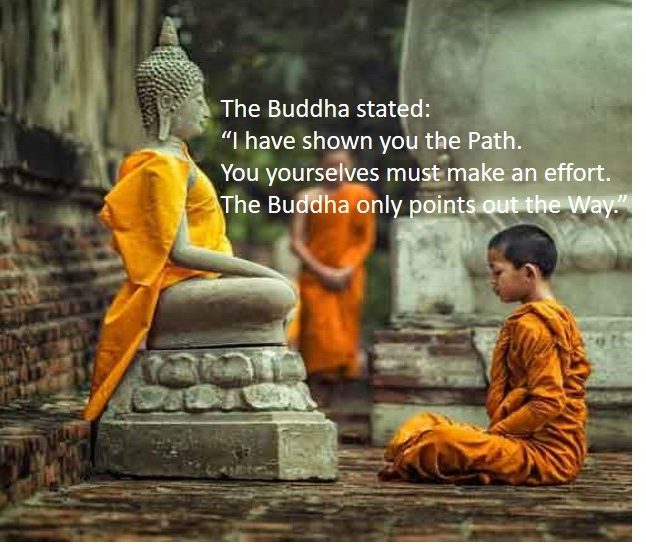Merit-Making in Buddhism: Its Benefits to Individuals and Society From Buddhist Beliefs to Scientific Evidences
Contents

-
Introduction
Merit-making, or meritorious deeds, constitutes a fundamental concept in Buddhism, encompassing various activities such as generosity, precept observance, and mental development. It transcends mere material gain, focusing instead on the cultivation of inner qualities. When undertaken with a pure and sincere heart, meritorious deeds not only benefit others but also contribute to our own happiness and personal growth. By performing good deeds, we inspire others through a positive example and foster a more harmonious and prosperous society. Our meritorious deeds may encourage others to follow suit, creating a ripple effect of positive change. Merit-making is a potent force for good in the world. Therefore, it is essential to grasp the concept of merit-making accurately, ensuring that our actions are meaningful, effective, and productive. Modern research recognizes merit-making and corroborates its benefits: for instance, studies show that acts of giving promote happiness in young children, adherence to the Buddhist ‘Five Precepts’ helps reduce stress and alleviate depression, and mental development, as evidenced in articles such as ’12 Science-Based Benefits of Meditation,’ offers numerous advantages.

Thai Buddhists ma king food offerings to monks.
-
Understanding Merit in Buddhism
The term “merit” in Buddhism finds its roots in the word “punya” in Sanskrit and “punna” in Pali.
In the Buddha’s era, the term “punya,” as an adjective, encompassed notions of auspiciousness, propitiousness, luck, and favorability, along with connotations of goodness, virtue, righteousness, and merit, as outlined in Arthur A. Macdonell’s Sanskrit English Dictionary (p. 164).
Similarly, according to the Pali-English Dictionary by T. W. Rhys Davids and William Stede, (pp. 1057-1058), “punna” denotes merit, meritorious action, and virtue. It is consistently portrayed as the foundation and condition for heavenly rebirth and a subsequent blissful state. The enjoyment and duration of this state hinge upon the amount of merit accumulated in a prior existence.
In the latest edition of P.A. Payutto’s Dictionary of Buddhism (45th edition in 2022, p. 334), “punya” has many meanings. As an adjective, it signifies “good” or “meritorious.” As a noun, it encompasses a range of interpretations such as “merit,” “good actions,” “virtue,” “righteousness,” “moral acts,” and “good works.” His booket on ‘Growing in Merit’ is strongly recommended for further reading.
In essence, merit in Buddhism is commonly understood as positive kamma (karma) actions and the outcomes of virtuous deeds. Engaging in acts of kindness and virtue is believed to yield positive consequences. When performed with sincerity and purity of heart, these benevolent actions generate positive kamma, fostering happiness and prosperity not only in the present life but also in future existences.
Doing good things is like planting seeds for happiness. Every meritorious deed, big or small, sows a little “kamma seed” that sprouts into positive outcomes. Punya could also be thought of as sunshine for the soul: Just like how sunshine helps plants grow, punya brings happiness and well-being not just now, but also in future lives. It’s like an investment in your own good kamma!
-
Merit-Making and Its Practices
Merit-making, also known as meritorious deeds, encompasses the intentional engagement in virtuous deeds, guided by three fundamental principles: generosity, observance of moral precepts, and mental development through meditation. The aim is to accumulate merit, thereby influencing one’s kamma and cultivating favorable conditions for happiness in both present and future lives.
Importantly, meritorious deeds transcend religious boundaries, resonating across diverse faiths such as Hinduism, Judaism, Christianity, Islam, Sikhism, and even among individuals without religious affiliations. Regardless of religious background, those who perform acts of kindness, practice humility, demonstrate reverence, or engage in meditation are considered to be participating in merit-making. The positive outcomes of these virtuous actions, such as reduced selfishness, strengthened relationships, and inner peace, are accessible to all who engage in them.
3.1 Two Versions of Merit-Making
In Buddhism, meritorious deeds are delineated in two main frameworks. The first comprises the three bases of merit-making, as elucidated by the Buddha himself at Jetavana (จะมีรูปเชตะวัน) Monastery in Śrāvastī, the capital of the Kosala Kingdom during the 6th century BCE. The second framework, known as the ten bases of meritorious action, expands upon the initial three bases. This elaboration was provided by Buddhaghosa, a prominent 5th-century Indian Theravada Buddhist commentator, translator, and philosopher.
The ruins of Jetavana Monastery,
where the Buddha expounded three types of merit-making, located in present-day Uttar Pradesh, India.
3.1.1 Three Grounds of Meritorious Deeds: Insights from the Buddha
The Buddha has addressed the issue of meritorious deeds in the Pali canon “punnakiriya-vatthu or punyakiriya-vatthu discourse,” which translates to the base or the ground of meritorious action or merit-making or the path of doing good, or just the three meritorious deeds.
In this discourse, the Buddha described three deeds that qualify as merit-making:
-
- Generosity or Giving (dana): This involves giving, sharing, and
distributing material resources that are beneficial to the recipients, with the intention of reducing suffering and alleviating needs.
In the article “Giving in the Pali Canon”, giving is highlighted as a great virtue and possibly the easiest meritorious deed that can be conducted. Since giving is a very uncomplicated act and laymen can relate effortlessly, it was the deed that the Buddha used to open his gradual sermon (Anupubbikatha).[1]
-
- Precept or Moral Behavior Observance (sila): This pertains to the cultivation of bodily, verbal, and mental virtues, creating an orderly and harmonious state of being. It involves practicing ethical behavior, maintaining good relationships, fostering mutual support, and avoiding harmful actions.
By engaging in these three meritorious deeds, individuals not only contribute to the well-being of others but also cultivate qualities within themselves that lead to personal development, happiness, and spiritual growth.
The Buddha’s Words on three meritorious deeds
The Buddhas expounded on three meritorious deeds stating,
“Monks, there are three grounds for making merit. What three? Giving (dana) as a ground for making merit, virtue/morality (sila)…, and meditation (bhavana)….” He also explained that one should train in practicing meritorious acts that will result in future happiness. One should practice giving and follow righteous living. One should develop a mind of loving kindness. By cultivating these three things that bring about happiness, the wise person is reborn in an untroubled, happy world.
3.1.2 Ten Grounds of Merit-Making: Extending the Three Grounds
The “three meritorious deeds” were later expanded by seven more deeds to encompass the “Ten Meritorious Deeds” by the commentator Buddhaghosa who lived and worked in Sri Lanka in the 5th-century, whose best-known work is the Visuddhimagga (“Path of Purification”), a comprehensive summary of Theravada teachings and practices.
Traditionally, the list of ten meritorious deeds is presented with the Buddha’s original three first, followed by Buddhaghosa’s seven additional ones. However, in the following list, I have grouped them in order of act, i.e. the first three are all related to giving.
The ten meritorious deeds include:
3.1.2.1. Merit-Making Done through Generosity or Giving (Danamaya)
Generosity involves giving to others without expecting anything in return. This includes sharing, sacrificing, and contributing, not only in terms of wealth, possessions, and necessities but also in terms of life force, knowledge, and skills. It encompasses imparting knowledge of arts and sciences, giving guidance and teaching, offering advice for life, and sharing wisdom, such as printing or disseminating Dhamma books. It also involves actively participating in benevolent activities for the benefit of others and the collective, promoting selflessness, and reducing selfishness, including letting go of material attachments. Ultimately, it extends to offering forgiveness.

Nurture a spirit of sharing in young ones.
Buddhaghosa expanded the concept of merit-making through generosity to encompass these ten types of meritorious deeds.
3.1.2.2 Merit-Making through Sharing or Giving out Merit (Pattidanamaya)
This merit-making refers to the merit achieved through the act of giving merit, which one just performed, to other beings. This involves dedicating a portion of one’s generosity and charitable deeds to benefit sentient beings. When one receives blessings, the aspiration is to share those blessings with others. This reflects a broad and compassionate heart, extending kindness and seeking the well-being of others.
3.1.2.3 Merit-Making through Rejoicing in the Merits of Others (Pattanumodanamaya)
This merit-making involves participating in rejoicing, expressing happiness, and sharing in the goodness of others. This is done by saying “Sādhu” (meaning “well done” or “congratulations”), even if one may not have had the opportunity to contribute directly. It is an invitation to cultivate a heart of appreciation, genuinely rejoicing in the virtuous deeds performed by others.
3.1.2.4 Merit-Making through Observing the Precepts or Moral Behavior (Silamaya)
This action refers to the intentional commitment to uphold moral precepts and conduct oneself in a way that does not violate these precepts. This applies to the five precepts for laypersons, the eight precepts observed on Uposatha days or by lay practitioners on retreats, the ten precepts for novice monks, the 227 precepts for fully ordained monks, or the 311 precepts for nuns. Moral precepts involve maintaining good physical and verbal behavior, ensuring that one’s actions and speech are in order. Keeping the body and speech in check becomes a norm, avoiding causing distress to others, and refraining from wrongful actions.
3.1.2.5 Merit-Making through Humility or Reverence (Apacayanamaya)
This is the merit gained through humble and respectful behavior towards elders and those deserving of reverence, categorized into at least three types:
- Individuals with age qualification: this includes fathers, mothers, siblings, and elderly relatives.
- Individuals with virtues or qualifications: this comprises venerable monks and teachers.
- Individuals with royal or noble qualifications: this involves kings or rulers, and those of noble lineage.
Displaying humility or reverence towards these three categories of individuals can be demonstrated through acts such as bowing, rising to welcome, using polite language, or showing respect in various ways. Such conduct leads to the flourishing of four blessings: a long life, radiant complexion, happiness, and robust health.
3.1.2.6 Merit-Making through Rendering Righteous Endeavors or Services (Veyyavacaccamaya)
This merit-making is attained through diligent engagement in righteous activities, involving actions that are beautiful and beneficial to the general welfare. This includes guiding individuals to conduct themselves morally, engaging in acts of generosity, observing moral precepts, and participating in the training and development of the mind.

Blind middle school students cared for at a tourist spot by Social Workers in Thailand (photo by the author).
3.1.2.7 Merit-Making through Mental Development (Bhavanamaya)
Meditative merit involves training and developing the mind to be calm, focused, strong, firm, and deeply concentrated using methods such as mindfulness of breath, loving-kindness meditation, and vipassana meditation. It aims to cultivate wisdom about the true nature of life and the world, leading to the purification of the mind through virtuous conduct. The practice promotes tranquility through mindfulness and brightness through wisdom, ultimately allowing the mind to experience greater happiness than suffering every day.
The process of training and developing the mind consists of two components. The first is the theoretical aspect, referred to in Buddhist terminology as “Dhammasavana” or listening to and understanding the teachings, resolving and cultivating correct beliefs, opinions, and understanding. The second is the practical aspect, known in Pali as “Kammatthana” or mental exercises, involves calming the mind to the point where it becomes serene, clean, free from impure feelings, anger, and delusions, resulting in a clear and undistorted perception of reality. These are the positive outcomes of mental development.
7-Day meditation retreat at Wat Phra Dhammakaya, Thailand.
Buddhaghosa expanded the concept of mental development to encompass these two types of meritorious deeds.
3.1.2.8 Merit-Making through Listening to Dhamma (Dhammassavanamaya)
It is the merit gained by actively listening to the teachings of the Dhamma. It means intentionally listening to Dhamma that one has not heard before or re-listening to deepen understanding, alleviate doubts, and clarify perceptions. This practice cultivates wisdom, resulting in a more accurate and clear comprehension. The knowledge and wisdom acquired through this process are then applied for the benefit of oneself and others in the future.
3.1.2.9 Merit-Making through Teaching Dhamma (Dhammadesanamaya)
It is the merit gained by embodying the principles of Dhamma in one’s actions, behavior, speech, or thoughts. It means setting a positive example for others, guiding them through virtuous conduct, and influencing them by aligning one’s behavior with the teachings of Dhamma. This can happen anywhere, whether at home, in the forest, in a vehicle, on a boat, on the streets, through radio broadcasts, television stations, or in formal teaching environments.
Disseminating the dhamma is considered more beneficial than various other forms of generosity, as the Buddha stated, “Giving the dhamma surpasses all other gifts.”
3.1.2.10 Merit-making through Correcting One’s Views(Ditthujukamaya)
This form of merit comes from developing a proper understanding of what is right and wrong, the difference between merit and demerit, as well as the subjects of wholesomeness and unwholesomeness, the paths of improvement and deterioration in life, and being able to distinguish between meaningful and meaningless actions that contribute to happiness and success. It also involves having a realistic outlook on the outcomes of our deeds, trusting in the effectiveness of doing good through both actions and words, ultimately resulting in personal happiness, prosperity, and contributing to a more harmonious and peaceful society.
The Buddha stated:
“Whatever sort of seed is sown,
That is the sort of fruit one reaps:
The doer of good reaps good;
The doer of evil reaps evil.”
-
Merit and Wholesomeness: Two Consecutive Steps Leading up to a Greater Height.
In Buddhism, the concept of “merit” (Punya) is considered a part of overall “wholesomeness” (Kusala). Kusala is divided into two parts: mundane wholesomeness (punya) and transcendent wholesomeness.
Engaging in the ten grounds of merit-making contributes to accumulation of merit and the development of wholesome qualities in an individual’s character, leading to positive consequences in both the present life and future existences and fostering spiritual progress.
 Bas-relief depicting the Buddha delivering his first sermon at
Bas-relief depicting the Buddha delivering his first sermon at
the ancient city of Varanasi (modern-day Sarnath) in Uttar Pradesh, India.
-
Understanding the Distinctive Relationship Between Merit, Demerit, Wholesomeness and Unwholesomeness
It is important to understand the meanings of these four related words, as it will help the reader to grasp their significance and intentions more effectively.
Among these four terms, ‘Punya’ or ‘Punna’ and ‘Papa’ were commonly used before the Buddha’s time. In the Rigveda, composed between circa 1500 and 1000 BCE, the term ‘Punya’ meant ‘good’ or ‘auspicious’ or ‘happy’ here. However, the term ‘Papa’ was coined later to refer to bad deeds, sin, various kinds of actions or behaviors considered morally wrong, or even one who is a sinner acts here.
The Buddha used these terms but redefined them to correspond with Buddhist principles (refer to Buddhadhamma, page 418).
The concept of merit has already been elucidated in section No. 2, ‘Understanding Merit in Buddhism.’ Furthermore, the term ‘Punya’ encompasses four distinct meanings: factors for purifying the underlying disposition of mind, factors leading to the fruition of a meritorious state of existence, factors leading to holiness, and factors bringing one’s wishes to fulfillment (Buddhadhamma, page 412).
The term demerit (Papa) is just the opposite of merit. Papa means factors leading to the round of suffering, or factors leading to a bad destination. Papa or sin also refers to evil, bad things, undesirable things, and things that are not pleasing to the wise. The motivation, cause, or root of Papa comes from what is collectively called kilesa (such as greed, anger, and delusion) that exist in the minds of all ordinary people. These defilements constantly control the mind to think and express various behaviors that lead to evil and cause the mind to degenerate, both consciously and unconsciously.
The term “wholesomeness” comes from the Pali word ‘Kusala,’ which translates to ‘skillful,’ ‘proficient,’ ‘dexterous,’ or ‘virtuous’ in English. Essentially, it refers to knowledge that reduces wrongdoing and reflects wisdom. Wholesomeness promotes well-being, is harmless, blameless, beneficial, and leads to happiness. It also denotes a state of mental health marked by a mind free from illness or afflictions. Developing wholesomeness strengthens the mind, allowing it to experience happiness, peace, and liberation.
The term unwholesomeness is the translation of the Pali word ‘Akusala,’ which can be interpreted as opposite to those definitions of Kusala above. The term refers to ‘an unsound state of mind, to a lack of mental health. It is just the opposite to those definitions of kusala above. Akusala weakens and impairs the mind.
Grasping the meanings of these four connected words is crucial for both ethical conduct and personal growth. Understanding their significance and intentions empowers the reader to participate in merit-making and wholesome actions, while avoiding demerit and unwholesome deeds, leading to positive outcomes for yourself and society, as the Buddha stated, “Neither good nor bad deeds are performed in vain” and “All accumulated deeds, both good and bad, bear fruit. Actions marked as kamma, even trifling ones, are not void of result.”
Remember, this framework serves as a guide, not a judgment, on your spiritual journey. To further clarify, a table below succinctly categorizes these concepts as bodily, verbal, and mental actions, distinguishing between wholesome and unwholesome acts for your improved understanding.
| Wholesomeness | Unwholesomeness | |
| Ten Bases of Merit-Making | Ten Wholesome Course of Action | Ten Unwholesome Course of Action
(Akusala Kamma) or Papa |
|
1. Merit acquired by giving |
1. To avoid the destruction of life, and be anxious for the welfare of all lives |
1. Destruction of life |
|
2. Merit achieved by sharing or giving out merit |
2.To avoid stealing, not violating the right to private property of others |
2. Stealing |
|
3. Merit done through rejoicing in others’ merit |
3.To avoid sexual misconduct, not transgressing sex morals |
3. Sexual misconduct |
|
4. Merit acquired by observing the precepts or moral behavior |
4. To avoid lying, not knowingly speaking a lie for the sake of any advantage |
4. False speech |
|
5. Merit achieved by humility or reverence |
5. To avoid malicious speech, unite the discordant, encourage the unity, and utter speech that makes for harmony |
5. Malicious speech |
|
6. Merit done through rendering services |
6. To avoid harsh language; but speak gentle, loving, courteous, dear and agreeable words |
6. Harsh speech |
|
7. Merit acquired by mental development |
7. To avoid frivolous talk; to speak at the right time, in accordance with facts, what is useful, moderate and full of sense |
7.Chatter; frivolity; vain talk; gossip |
|
8. Merit achieved by listening to the Doctrine or right teaching |
8. To be without covetousness |
8. Covetousness; avarice |
|
9. Merit done through teaching the Doctrine or showing truth |
9. To be free from ill-will, thinking ‘Oh, that these beings were free from hatred and ill-will, and would lead a happy life free from trouble.’ |
9. Ill will |
| 10. Merit obtained by straightening one’s views or forming correct views | 10. To possess right view such as that gifts, donations and offerings are not fruitless and that there are results of wholesome and unwholesome actions. | 10. Wrong view |
A young novice, clad in saffron robes, sits in serene meditation before a Buddha statue in Thailand.
Understanding the concepts of ‘merit,’ ‘demerit,’ ‘wholesome,’ and ‘unwholesome,’ empowers us to make conscious choices towards engaging in virtuous actions while steering clear of harmful ones, as the Buddha stated, below:
“Whatever action is performed is visible within oneself.”
“…deeds of bodily good conduct, verbal good conduct, and mental good conduct are to be done because in acting thus these blessings are to be expected: one does not blame oneself; the wise, having investigated, praise one; a good reputation circulated about one; one dies unconfused; and with the breaking of the body, after death, one is reborn in a good destination, in a heavenly world.”
“…deeds of bodily misconduct, verbal misconduct, and mental misconduct are not to be done because in acting thus these dangers are to be expected: one blames oneself, the wise, having investigated, censure one; a bad report circulated about one; one dies confused; and with the braking up of the body, after that, one is reborn in the plane of misery, in a bad destination, in the lower world, in hell.”
“The meritorious deeds one has done-that is one’s friend in the future.”
(For a detailed exploration of this section, please refer to Buddhadhamma, pp. 403-443.)
-
Benefits of Merit-Making and Their Scientific Evidences
Merit-making encompasses three essential practices: giving, precept observance, and mental development.
Before delving into the specific benefits, let’s begin by introducing a verse from the Punnakiriyavatthu Sutta (found on page 162), where the Buddha expounds on merit-making and its benefits. The verse states:
“…One should truly train in merit—
fruiting in lasting and foremost happiness,
giving and calm [harmonious] conduct and
should cultivate a heart of loving-kindness.
Having cultivated these states
Three, happiness arises,
into a happy trouble-free world,
the wise are reborn.”
The verse conveys the idea that individuals should concentrate on accumulating good deeds, resulting in lasting and ultimate happiness. This entails practicing generosity, upholding peaceful behavior, and nurturing a heart filled with kindness. Through the cultivation of these three qualities, happiness arises, and the wise person is reborn into a joyful and trouble-free world.
Additionally, the Pali canon outlines numerous benefits associated with merit-making through main acts of generosity, precept observance, and mental development.
6.1 Benefits of Generosity (Dana):
The e-book ‘DĀNA The Practice of Giving‘ succinctly captures and condenses these advantages. According to the Aṅguttara Nikāya (AN 7:54), generosity bestows several worldly advantages. A generous person, as opposed to a miser, gains the sympathy of others, builds a positive reputation, attends gatherings with confidence and dignity, and is reborn into a state of happiness after death.
The Māgha Sutta (Sn 506) emphasizes that hate diminishes when one is established in generosity. Being generous earns the love of others, and many people are drawn to associate with such an individual (AN 5:34). Additionally, giving fosters the cementing of friendships (Sn 187).
Another sutta (AN 5:35) further highlights that a generous person becomes popular, attracts people of noble character, and experiences the satisfaction of fulfilling the duties of a layperson.
Contemporary research on Buddhist Generosity: Its Conceptual Model and Empirical Tests has also discovered a connection between generosity and optimism, hope, and altruism. It also showed that being generous helps explain why kindness towards others leads to happiness.
6.2 Benefits of Precept Observance (Sila):
The Buddha provided extensive teachings on the profound importance of moral conduct, emphasizing its relevance for both monastic practitioners and lay followers. For instance, in the Maha-parinibbana Sutta: Last Days of the Buddha (No. 24), the Buddha addressed to lay devotees in Pataligama who adhere to the Five Precepts (pañca-sila), elucidating the positive outcomes of leading a virtuous life. He enumerated these blessings as follows: increased wealth through diligence, a favorable reputation, confident deportment in all social circles, a peaceful death, and rebirth in a happy heavenly state after passing away.
The Five Precepts comprise two components: the prohibitive aspect, known as the ‘precepts,’ and the complementary aspect that should be cultivated simultaneously, termed ‘virtue,’ which are related to modern day’s human rights as depicted in the Principles table, below.
| Precept | Accompanying virtues | Related to human rights |
| 1. Abstention from killing living beings | Kindness and compassion | Right to life |
| 2. Abstention from theft | Generosity and renunciation | Right of property |
| 3. Abstention from sexual misconduct | Contentment and respect for faithfulness | Right to fidelity in marriage |
| 4. Abstention from speaking lies (falsehood) | Being honest and dependable | Right of human dignity |
| 5. Abstention from intoxication | Mindfulness and responsibility | Right of security and safety |
When instructing fully-ordained monks or “bhikkhu and nuns or “bhikkhuni”, the Buddha delved into various aspects of moral conduct. For instance, in a conversation with his private secretary, Ananda bhikkhu, the Buddha outlined the rewards of virtue for monks and nuns:
- Guilt-Free Existence:
- [Ananda:] “What, Revered One, are the rewards and blessings of leading a good and moral life?”
-
- [The Buddha:] “Being free from guilt or regret, Ananda” — denoting a sense of peace knowing one has not wronged anyone.
- Joyful Feelings:
- “And what comes from being free from guilt or regret?”
- “Feelings of joy, Ananda” — suggesting a clear conscience brings lightness and happiness.
- Excitement and Intensity:
- “And what follows joy?”
- “A sense of excitement, Ananda” — implying joy deepens into intense, almost ecstatic feelings.
- Calm and Inner Peace:
- “And after excitement?”
- “A state of calm and peace, Ananda” — indicating that intense joy settles into profound inner peace.
- Contentment and Lasting Happiness:
- “And following tranquility?”
- “Inner contentment and happiness, Ananda” — revealing that peace becomes a lasting, unshakeable state of well-being.
- Deep Focus and Concentration:
- “And from happiness?”
- “Deep focus and concentration, Ananda” — highlighting that a calm mind can focus deeply and effortlessly.
- Insight and Understanding:
- “And what arises from concentration?”
- “Insight and understanding about reality” — clarifying that one sees things without distortions or biases.
- Turning Away from Attachments:
- “And what follows this insight and understanding?”
- “A turning away from worldly attachments and a sense of detachment, Ananda” — signifying that understanding reality allows letting go of clinging and craving, releasing oneself from suffering.
- Liberation and Ultimate Fulfillment:
- “And what comes from turning away and detachment?”
- “Understanding and knowledge leading to liberation, Ananda” — concluding that practicing virtue leads to freedom from the cycle of birth, death, and rebirth, reaching a state of ultimate peace and fulfillment.
In essence, the practice of virtue is likened to ascending a mountain, with each step bringing one closer to a breathtaking view of reality and ultimately leading to the summit of liberation.
Three men ascending a mountain.
Empirical Studies on the Benefits of the Five Precepts
- Stress Reduction and Depression Buffering:
The study titled “Moderating role of observing the five precepts of Buddhism on neuroticism, perceived stress, and depressive symptoms” discovered
that observing the Five Precepts was linked to lower levels of neuroticism, perceived stress, and depressive symptoms.
- Bridge to Happiness:
In the study titled “Observance of the Buddhist Five Precepts, Subjective Wealth, and Happiness among Buddhists in Bangkok, Thailand,” it is affirmed
that living a fulfilling life, where you feel you have what you need mentally and emotionally, helps connect following the Five Precepts with feeling happy.
6.3 Benefits of Mental Development (Bhavana): From Ultimate Spiritual Liberation to Inhale Serenity, to Exhale Stress in the Present
Mental development or cultivation, better known as ‘Buddhist meditation’ opens a doorway to profound mental, emotional, and spiritual benefits.
The Buddha has enumerated seven benefits of Mindfulness Meditation in
Mahasatipatthana Sutta p. 7, which are:
- Purification from all kinds of defilements.
- Overcoming sorrow and worry.
- Overcoming lamentation.
- Cessation of all kinds of physical suffering.
- Cessation of all kinds of mental suffering.
- Attainment of enlightenment.
- Attainment of nibbana (ultimate liberation).
Drawing upon the Pali canon and commentaries, Thai Buddhist scholar monk P. A. Payutto meticulously outlines the overarching objectives and benefits of meditation or concentration in his book “Buddhadhamma, the Laws of Nature and Their Benefits to Life” (pp. 1779-1783). Broadly categorized, the benefits can be understood across four levels:
6.3.1 Spiritual Liberation: The ultimate goal is the freedom from all suffering and mental impurity, culminating in the ‘knowledge and vision of things as they really are, leading to true knowledge and liberation.
6.3.2 Psychic Development: A secondary goal involves the cultivation of exceptional psychic abilities, including the ‘divine ear,’ clairvoyance, telepathy, and recollection of past lives.
6.3.3 Mental Health and Personality: The third goal encompasses robust mental health and a healthy personality characterized by inner strength, decisiveness, vigor, resilience, tranquility, cool-headedness, joy, loving-kindness, compassion, and wise discernment.
 Meditation brings about calmness, which is an antidote to road rage.
Meditation brings about calmness, which is an antidote to road rage.
In essence, the practice of Buddhist meditation not only contributes to stress reduction but also paves the way for profound mental and spiritual well-being.
Meditation’s Impact on Mental Health: Scientific Evidences
The assertion that meditation significantly influences mental health is not merely hype, it is supported by scientific evidence. There have been many studies, such as “Meditation and Mental Health“, that firmly establishes the scientific backing for the claimed benefits. The American Psychological Association (APA) affirms these findings in their article on “Mindfulness,” underscoring the advantages, even in sports. Psychology Today provides additional support with “18 Science-Backed Reasons to Try Loving-Kindness Meditation.” The Harvard Health Blog emphasizes that mindfulness meditation holds the potential to ease anxiety and mental stress. And scientific scrutiny extends to its effect on creative thinking.
6.3.4 Everyday Life Benefits: A Holistic Approach
In the realm of everyday life, meditation reveals a spectrum of advantages, falling into three key sub-groups:
6.3.4.1 Physical and Mental Well-being: Meditation contributes to bodily and mental relaxation, inner peace, happiness, stress reduction, and the alleviation of depression.
The American Psychological Association (APA) reinforces this in their article on “Mindfulness Meditation: A Research-Proven Way to Reduce Stress,” affirming that mindfulness meditation positively impacts both mental and physical health.
6.3.4.2 Enhanced Capabilities: Meditation enhances a person’s abilities in work, study, and various activities.
Harvard Business Review explores “How Meditation Benefits CEOs,” highlighting mindfulness as a tool for becoming a better leader.
Other researches delve into when mindfulness is effective at work, and enhances focus and attention.
6.3.4.3 Health Promotion: Meditation contributes to physical health and aids in the healing of illnesses.
Scientific research attests to these benefits, as evidenced in sources such as positivepsychology.com’s article on the “20+ Health Benefits of Meditation” and UC Berkeley Greater Good Science Center’s exploration of “Meditation Enhances Self-Awareness and Emotional Regulation.”
6.4 How to Meditate, and How Often and How Long to Meditate Per Session
There are many ways to meditate, but two of the most popular are Anapanasati (mindfulness of breathing) and Brahmavihara (loving-kindness meditation). In this article, I will briefly discuss these two methods. Those who are interested can read more about meditation and its benefits, both according to the teachings of the Buddha and according to scientific research, in my other articles in Spiritual values & Meditation, such as my latest article, A Buddhist Guide to New Year: The Secrets to a Successful 2024.
6.4.1 How to Meditate Anapanasati and Brahmavihara
Anapanasati is a simple yet powerful meditation technique that involves focusing on the breath. As you breathe in, you mentally say “Bud” or “one” and as you breathe out, you mentally say “Dho” Or “one” again. You can do this silently or aloud, whichever you prefer. The goal is to simply observe the breath without trying to control it. If your mind wanders, gently bring it back to the breath.
Brahmavihara is a meditation technique that involves cultivating four positive qualities: loving-kindness (metta), compassion (karuna), joy (mudita), and equanimity (upekkha). You can practice this meditation by silently repeating phrases such as “May I be happy” or “May all beings be happy.” The goal is to develop a sense of love and compassion for yourself, others, and all living beings.
In daily life, the practice of loving-kindness meditation involves generating thoughts of loving-kindness when encountering other human or living beings, such as ‘May you be happy, healthy, prosperous, and successful.’ I personally find this practice fulfilling and uplifting.
For concise details on how to meditate, please see my article on Meditation in Thailand.
6.4.2 How Often and How Long to Meditate Per Session
Ideally, meditation should be practiced daily, regularly and at the same time, like advice given by Buddhist monk Henepola Gunaratana on meditation in everyday life, pp. 165-177 here.
The duration, however, varies, depending on the levels and purposes of practice. For example, as suggested in the “16 Health Benefits of Daily Meditation According to Science” here, in each session, it may be 2-5 minutes for a beginner, 4-15 minutes for an intermediate, and 20-30 minutes for a proficient meditator. CNN on the science behind meditation suggests at least 10 minutes a session here.
A beginner may, therefore, start with a 2-minute session, then, as the mind gets used to the practice, he or she could increase the time span by a minute or two each session, aiming for a final 30-minute session daily – for psychological and biological health as shown in ABC’s science of meditation here.
-
Examples of Merit-Making in the Thai Way of Life
Throughout history, Thai Buddhists have embraced the tradition of making merit (in Thai), categorizing their practices into three distinct dimensions:
7.1 Daily Merit-Making: This involves offering alms to monks and novices during their morning food collection.
7.2 Occasional Merit-Making: Observing precepts and meditation, and offerings on Buddhist holy days like Visakha Puja, Asalha Puja, Magha Puja, Buddhist Lent Commencement Day, and Buddhist Rains Retreat Closing Day, as well as offering Kathina robes to monks.
7.3 Merit-Making on Special Occasions:
7.3.1 Auspicious Occasions: Celebratory events such as births, weddings, graduations, and moving into a new house. Merit-making during these occasions involves giving alms to monks or donating to temples, seeking blessings for health, happiness, and prosperity.
 Thai Buddhists offering a meal to monks as part of a New Year celebration at their home.
Thai Buddhists offering a meal to monks as part of a New Year celebration at their home.
7.3.2 Inauspicious Occasions: In response to unfavorable events like illness or death. Making merit through almsgiving or temple donations to pray for recovery or aid the deceased’s journey towards a positive rebirth. Specific instances include the 7th, 50th, and 100th days after death, along with the day of the funeral or cremation.

Mourners gathered at a Buddhist funeral, performed by monks reciting verses from the Abhidhamma Sutta (photo by the author).
Conclusion: Cultivating Your Future with Merit-Making
Merit-making isn’t just about accumulating points; it’s a seed we sow for a brighter future. By practicing generosity, compassion, and ethical conduct, we nourish inner qualities like kindness, peace, and wisdom. This not only benefits our own well-being but also contributes to a more harmonious and compassionate society. As the Buddha said, “The doer of good reaps good; the doer of evil reaps evil.” When we plant seeds of good deeds, we cultivate fertile ground for a future filled with happiness, peace, and liberation from suffering, not just for ourselves but for others as well. Remember, “the meritorious deeds one has done – that is one’s friend in the future.” Let this reminder inspire us to embark on our own journey of merit-making and witness the positive transformation it brings to our lives and the world around us.
May the wisdom gleaned from these teachings guide us all towards a life of profound merit and fulfillment.
……
References
- Aknin, L. B., Hamlin, J. K., & Dunn, E. W. (2012). Giving leads to happiness in young children. American Psychology Association. Retrieved from https://psycnet.apa.org/record/2012-17354-001
- Bergland, Christopher. (2022). Buddhist Precepts Reduce Stress and Buffer Depression: Study. Psychology Today. Retrieved from https://www.psychologytoday.com/intl/blog/the-athletes-way/202212/buddhist-precepts-reduce-stress-and-buffer-depression-study
- Thorpe, Matthew, Ajmera, Rachael. (2023). 12 Science-Based Benefits of Meditation. Healthline. Retrieved from https://www.healthline.com/nutrition/12-benefits-of-meditation
- Encyclopedia of Buddhism. (n.d.). Puṇya. Retrieved February 14, 2024, from https://encyclopediaofbuddhism.org/wiki/Pu%E1%B9%87ya
- Wisdom Library. (n.d.). Puṇṇa, Puṇña, Punnā, Tham-boon: 8 definitions. Retrieved February 14, 2024, from https://www.wisdomlib.org/definition/punna (Definition 1 of Pali-English Dictionary)
- Macdonell, Anthony, A. (1893). A Sanskrit-English Dictionary. Punya, page 164. Internet Archive. Retrieved from https://archive.org/details/afr4858.0001.001.umich.edu/page/164/mode/2up
- Davids, T.W. Rhys, Stede, William. (n.d.). The Pali Text Society. Pāli-English Dictionary. … page. Retrieved from https://www.academia.edu/44185258/Pali_English_Dictionary_Free
- Buddhaghosacariya, Somdet Phra, (Payutto, P.A.). (2021). Buddhadhamma, The Laws of Nature and Their Benefits to Life. Retrieved from https://www.thailandfoundation.or.th/wp-content/uploads/2021/09/Buddhadhamma.pdf
- Buddhaghosacharya, Somdet Phra, (Payutto, P.A.). (2022). Dictionary of Buddhism. 45th edition. Bangkok, Thailand. ISBN974-8357-89-9.
- Buddhaghosacharya, Somdet Phra (Payutto, P. A.). (2022). สมเด็จพระพุทธโฆษาจารย์ (ป.อ. ปยุตฺโต). พ.ศ. ๒๕๖๕. พจนานุกรมพุทธศาสตร์ ฉบับประมวลศัพท์ (translated into) The Buddhist Dictionary. ISBN974-575-029-8.
- Buddhaghosacariya, Somdet Phra (Payutto, P. A.). (2018). Growing in Merit. Bangkok, Thailand. Retrieved from file:///C:/Users/paitoon.son/Downloads/Growing%20in%20Merit.pdf
- wikipedia.org. (n.d.). Karma. Retrieved from https://en.wikipedia.org/wiki/Karma_in_Buddhism
- wikipedia.org. (n.d.). Buddhaghosa. Retrieved from https://en.wikipedia.org/wiki/Buddhaghosa
- wikipedia.org. (n.d.). Theravada. Retrieved from https://en.wikipedia.org/wiki/Theravada
- Trawell. (n.d.). Jetavana Monastery. Retrieved from https://www.trawell.in/uttar-pradesh/shravasti/jetavana-monastery
- Tan, Piya. (2008). Puññakiriyavatthu Sutta. (PDF). …
- 17. Bodhi, (1995). Dana, The Practice of Giving. Retrieved from https://www.accesstoinsight.org/lib/authors/various/wheel367.html
- wikipedia.org. (n.d.). Buddhist ethics. Subtopic ‘Precepts’ of the entry. Retrieved from https://en.wikipedia.org/wiki/Buddhist_ethics
- wikipedia.org. (n.d.). Bhavana. Retrieved from https://en.wikipedia.org/wiki/Bhavana
- Suttafriends.org. (n.d.). Grounds for Making Merits. Retrieved from https://suttafriends.org/sutta/itv60/
- Aristeinhk.blogspot.com. (2015). Ten Bases of Meritorious Actions (Ten Punnakiriya-vatthus). Retrieved from https://aristeinhk.blogspot.com/2015/10/ten-bases-of-meritorious-actions-ten.html
- Verywellmind.com. (2023). What Is Mindfulness Meditation? Retrieved from https://www.verywellmind.com/mindfulness-meditation-88369
- Positivepsychology.com. (2019). What Is Loving-Kindness Meditation? (Incl. 4 Metta Scripts). Retrieved from https://positivepsychology.com/loving-kindness-meditation/
- Dhamma.org. (n.d.). Vipassana Meditation. Retrieved from https://www.dhamma.org/en/about/vipassana
- Thich Nhat-Tu, Bhikkhu. Buddhivihara.org. (n.d.). Kusala and Akusala as Criteria of Buddhist Ethics. Retrieved from https://www.buddhivihara.org/kusala-and-akusala-as-criteria-of-buddhist-ethics/
- Wisdomlib.org. (n.d.). Papa, Papā, Pāpa, Pāpā: 28 definitions. Definition ‘Pāpa, (adj. nt.)’ in subtopic ‘Pali-English dictionary’. Retrieved from https://www.wisdomlib.org/definition/papa
- Ariyabuddhiphongs, Vanchai. Brill.com. (2016). Buddhist Generosity: Its Conceptual Model and Empirical Tests. Retrieved from https://brill.com/view/journals/arp/38/3/article-p316_4.xml
- Vajira, Sister & Story, Francis. Accesstoinsight.org. (1998). Maha-parinibbana Sutta: Last Days of the Buddha. Retrieved from https://www.accesstoinsight.org/tipitaka/dn/dn.16.1-6.vaji.html
- Wongpakaran, Nahathai; Pooriwarangkakul, Phurich; Suwannachot, Nadnipa; Mirnics, Zsuzsanna; Kövi, Zsuzsanna; Wongpakaran, Tinakon. Journals.plos.org. (2022). Moderating role of observing the five precepts of Buddhism on neuroticism, perceived stress, and depressive symptoms. Retrieved from https://journals.plos.org/plosone/article?id=10.1371/journal.pone.0277351
- Researchgate.net. (2010). Observance of the Buddhist Five Precepts, Subjective Wealth, and Happiness among Buddhists in Bangkok, Thailand. Retrieved from https://www.researchgate.net/publication/233567632_Observance_of_the_Buddhist_Five_Precepts_Subjective_Wealth_and_Happiness_among_Buddhists_in_Bangkok_Thailand
- Ahmad, Samoon M.D. Psychologytoday.com. (2019). Meditation and Mental Health, Does the science support the hype? Retrieved from https://www.psychologytoday.com/us/blog/balanced/201907/meditation-and-mental-health
- American Psychological Association. Mindfulness. Retrieved from https://www.apa.org/topics/mindfulness
- Harvard Health Blog. (2014). Mindfulness meditation may ease anxiety, mental stress. Retrieved from https://www.health.harvard.edu/blog/mindfulness-meditation-may-ease-anxiety-mental-stress-201401086967
- Capurso, Viviana; Fabbro, Franco; and Crescentini, Cristiano. National Library of Medicine. (2014). Mindful creativity: the influence of mindfulness meditation on creative thinking. Retrieved from https://www.ncbi.nlm.nih.gov/pmc/articles/PMC3887545/
- Seppälä, Emma. Harvard Business Review. (2015). How Meditation Benefits CEOs. Retrieved from https://hbr.org/2015/12/how-meditation-benefits-ceos
- Columbia School of Professional Studies. (2021). How Meditation Can Help You Focus. Retrieved from https://sps.columbia.edu/news/how-meditation-can-help-you-focus
- Gunaratana, Bhante. Archive.org. (1991). Mindfulness In Plain English. Retrieved from https://archive.org/details/mindfulness-in-plain-english-bhante-gunaratana/page/176/mode/2up
- Dhammathai.org. ธรรมะไทย Thai Dhamma, หมวดบุญพิธี (translated into) Categories of Merit-Making Activities. Retrieved from http://www.dhammathai.org/practice/practice2.php
- Sawanond, Dr. Nonglukshana. (2021). บุญกิริยาวัตถุธรรมสู่การพ้นทุกข์ (translated into) The Path to Liberation Through Meritorious Deeds. ดร. นงลักษณ์ สะวานนท์ พิมพ์ครั้งที่ 3. พ.ศ. 2564

Author: Paitoon Songkaeo, Ph.D.
Transitioning from a Buddhist monk to a diplomat, Paitoon Songkaeo is the Administrative Director of the Thailand Foundation. With a background of 16 years as a Buddhist monk, he later joined the Ministry of Foreign Affairs and retired as the Consul-General of Kota Baru in Malaysia in 2017. Additionally, he is a regular contributor to the Spiritual Values & Meditation section.
Uploaded on February 28, 2024







